Requirements for ventilation of public buildings: subtleties of arrangement and design of ventilation
Air quality is one of the most important indicators of the human environment.Any public place must be equipped with a ventilation system that will ensure the removal of polluted air from the premises and replace it with clean outdoor air.
High requirements for ventilation of public buildings are dictated not only by sanitary and hygienic standards, but also by concern for the comfort of visitors. After all, you must admit, it is not very pleasant to be in a room where there are many odors in the air, and not always pleasant ones.
Next, we will tell you what regulations regulate the indoor climate and how ventilation can be arranged in rooms for various purposes.
The content of the article:
Microclimate in various types of premises
The ventilation system diagram is developed when designing the building. Engineers and designers take into account the specifics of the structure, architectural features, and differences in climate conditions in the premises.
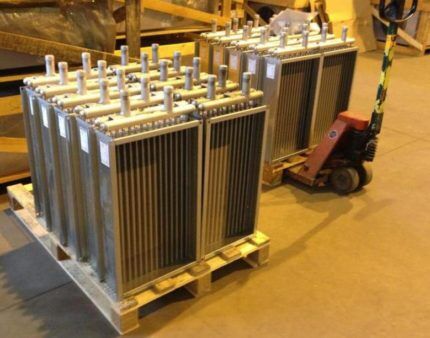
Regulatory documents establishing the limits of microclimate limits come to the aid of specialists:
- SP 7.13130.2013;
- SP 60.13330.2016;
- SP 252.1325800.2016.
Before starting work on air conditioning system design and ventilation of public buildings, it is necessary to determine which category the building belongs to.
By GOST 30494-2011 categories highlighted:
- 1st category. It includes all rooms in which people are in a state of rest and rest, lying or sitting.
- 2nd category. The building is intended for mental work or study.
- 3a. The premises are characterized by large numbers of people without warm outerwear, mostly sitting.
- 3b. The premises are occupied by people in street clothes, usually sitting.
- 3c. In the premises there are people in street clothes, standing.
- Category 4. Places for outdoor sports.
- Category 5. Premises of this type require the presence of scantily clad people (swimming pools, gyms).
- 6 categories. This category includes premises where people stay for a short time (storage rooms, bathrooms, lobbies, corridors).
Engineers face a rather difficult task in ensuring optimal parameters in each room.
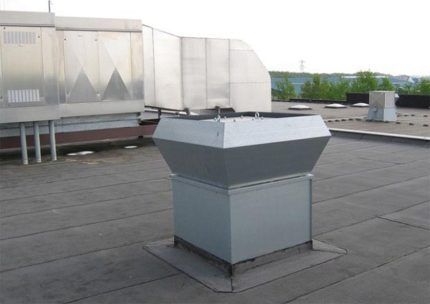
According to standards, the room should constantly receive 20-30 m3 fresh air per person. There is currently controversy surrounding this meaning. With such an influx, a draft can occur, which is very unpleasant in the cold season, when the heating elements of the ventilation simply do not have time to warm the air flow to a comfortable temperature.
Another method for calculating the required air exchange is based on the formula:
V=3 m3 * S,
Where S— room area.
Accordingly, there are 3 cubic meters of air per square meter. This method is used, as a rule, to calculate the required influx in a residential area, But SNiP 05/31/2003 allow such a calculation for offices in an administrative public building.
In calculations for some rooms, such as a toilet, smoking room, kitchen, the air exchange rate is used as a value that determines the parameters of the ventilation system.
This is a value that characterizes how many times the entire volume of air in the room will be replaced within one hour. For the kitchen, the minimum acceptable value is 3 rpm, for the toilet - 5 rpm, for the smoking room - 7 rpm. This calculation is only suitable for small rooms where people stay for a short time.
For small branches general exchange For ventilation it is more rational to use round duct fans, they can be installed in any position
Ventilation system implementation options
The implementation of high-quality ventilation and air conditioning systems for public premises is the key to the comfort and well-being of people. There are several basic technical solutions for these engineering systems.
General exchange stacked ventilation
The exhaust part of the ventilation system is needed to remove polluted air, excess moisture and heat from the room.
Its correct operation depends on a constant flow of air. To do this, you need supply ventilation that supplies fresh air from outside the room.

Built-in exhaust ventilation consists of: an external grille, a fan, an automation unit, air ducts, exhaust hoods (kitchen, laboratory), internal grille or exhaust hoods diffusers.
For supply ventilation, the following components are needed: an external grille, filter, air heater, muffler, humidity, temperature, frost sensors, fan, air ducts, internal wall or ceiling grilles, supply diffusers.
This type of ventilation is used most often in public buildings. Several branches are installed in the building general exchange ventilation systems that do not communicate with each other.
The advantage of modular ventilation is separate air purification in different rooms, the ability to regulate the power of the air flow in each room. But such an engineering solution also has a number of disadvantages. The main one is bulkiness. In buildings where it is not possible to hide air ducts behind a suspended ceiling, problems arise with the aesthetics of this structure.
In the case where ventilation is interfloor, vertical air ducts are mounted using the method of extension from above or extension from below.
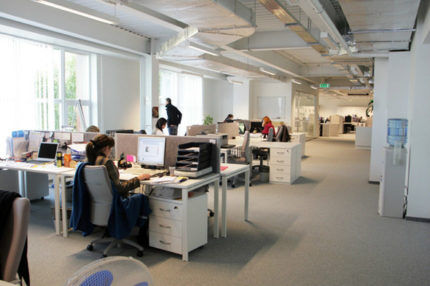
Some bars and restaurants use ductwork as part of their decor. In this case, stainless steel air ducts are usually used. In general, carefully installed ventilation fits into the interior of the establishment.
To suppress noise, air ducts are covered with insulating material, which effectively prevents the spread of sounds between individual rooms and practically reduces air noise in the air ducts themselves to zero.
This ventilation system is suitable for buildings with a large number of separate rooms.
Supply and exhaust ventilation with recovery
This ventilation system differs from the previous version by the presence recuperator — surface type heat exchanger.It is installed at the intersection of the supply and exhaust ventilation branches.
The air removed from the room leaves heat on the heat exchanger plates. The air that enters through the supply system is heated by its ceramic plates.
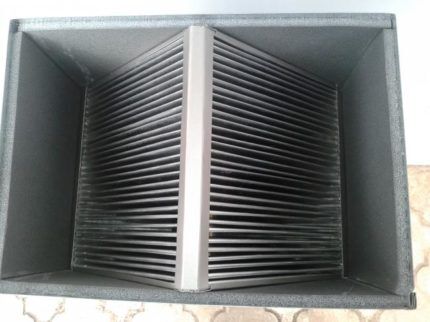
Check valves in the recuperator housing prevent air from escaping between the ventilation branches.
Recuperation allows for significant savings on heating costs. This advantage of the recuperator is especially noticeable in a large room: a conference hall, a cinema, an assembly hall.
Air handling units
The use of a ventilation unit discourages many building owners due to the high price of the unit itself. It is an all-in-one device - the main elements are located in the body.
Some models are equipped with an air cooler. Unfortunately, it is difficult to use it for air conditioning a large number of rooms for different purposes. This occurs due to the inability to set individual temperature conditions for each individual room.
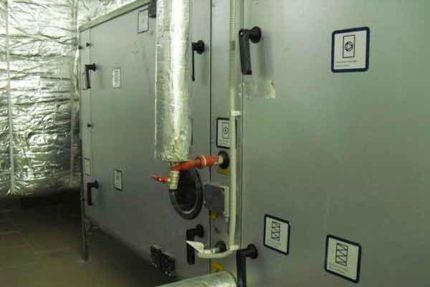
Supply and exhaust units are the simplest option for organizing a ventilation system. A fairly compact device does not take up much space in the ventilation chamber.
Due to the fact that the fans are located inside a well-insulated case, the noise level varies from air handling unit below. Maintenance of installations is much cheaper than typesetting systems.Their disadvantage is the need to install additional ventilation equipment in bathrooms, smoking rooms, server.
Smoke and fire ventilation
All ventilation equipment must be installed in accordance with fire safety regulations SP 7.13130.2013. These simple rules cannot be ignored when developing a circuit and installing it. Any building, especially a public one, must be equipped with fire and smoke ventilation of proper quality.
The spread of fire and smoke through the duct system is a significant problem during a fire. To combat it, fire dampers with a temperature sensor are installed in the air ducts.
Under normal conditions it is constantly open. When the temperature rises to extreme levels, a sensor is triggered, which activates the valve actuator. After closing, the seal applied to the edge of the valve expands, fitting as tightly as possible to the air duct.
Smoke in the premises hinders evacuation and complicates the work of firefighters. It is not possible to completely get rid of smoke, but you can minimize its harm by installing booster fans and smoke removal.
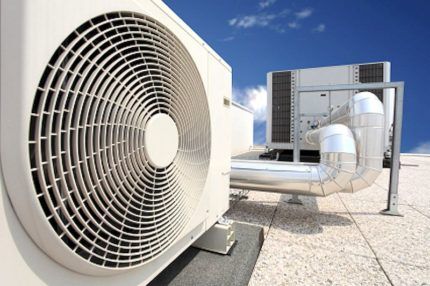
Smoke ventilation booster fans are necessary to provide people along the escape route with clean air. By pumping air into crowded areas (evacuation corridors, stairwells), it increases the pressure, preventing smoke from penetrating there.
Conclusions and useful video on the topic
You can learn how to install ventilation systems from the following video:
Ignore fire safety regulations or SanPiN is impossible, despite the high cost or inconvenience of their implementation. The number of technical solutions for ventilation of public buildings is quite large.
For each project, you need to select and search for a method of implementing a ventilation system that will meet the stated requirements. But, if there is not enough experience in this area, it is better to contact specialists who will help you properly design and equip the ventilation system.
Please ask your questions on the topic of the article, share your experience and valuable tips on arranging ventilation. The communication block is located below.



